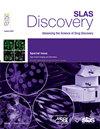高通量筛选鉴定BRD4和RIPK3双抑制剂,开发小分子抗砷医学对策剂。
IF 2.7
4区 生物学
Q2 BIOCHEMICAL RESEARCH METHODS
引用次数: 0
摘要
战争砷是强效的起泡剂,皮肤接触后会引起严重的炎症。我们小组的数据(未发表)表明,这些化学物质通过激活溴域-4和RIPK信号发挥作用。为了开发含溴结构域蛋白4 (BRD4)和受体相互作用丝氨酸/苏氨酸蛋白激酶3 (RIPK3)的双重抑制剂,我们对BRD4和RIPK3活性抑制剂进行了高通量筛选(HTS),以确定可以减轻砷诱导损伤的抗炎药候选物。我们的主要分析适用于384孔微孔板,用于筛选由fda批准的药物和其他生物活性化合物组成的4,074种化合物。BRD4主筛的平均Z′值为0.93,S/B比为3018;RIPK3主筛的平均Z′值为0.86,S/B = 12.6。使用反筛测定来确保活性是由于目标接触而不是测定干扰。在初级筛选中,hit抑制BRD4结合的>为54.6%,激酶活性的>为22.4%,在反筛试验中没有统计学异常值,在浓度-反应格式中得到证实。hit还通过基于细胞的IL-6检测来确定相应的炎症抑制活性。18种化合物在BRD4和RIPK3检测中均有活性,其中3种化合物的IC50值< 10 μM,具有良好的IL-6抑制作用。这些化合物可以作为进一步化学优化的良好候选者,用于开发小分子抗砷药物。本文章由计算机程序翻译,如有差异,请以英文原文为准。
High-throughput screening for the identification of dual inhibitors of BRD4 and RIPK3 toward the development of small-molecule medical countermeasure agents against arsenicals
Warfare arsenicals are potent blistering agents and cause severe inflammation following their skin exposure. Data from our group (unpublished) show that these chemicals act by activating bromodomain-4 and RIPK signaling. To develop a dual inhibitor of the bromodomain-containing protein 4 (BRD4) and the receptor-interacting serine/threonine-protein kinase 3 (RIPK3), we conducted a high-throughput screening (HTS) campaign for inhibitors of BRD4 and RIPK3 activity to identify anti-inflammatory agent candidates that could alleviate arsenicals-induced injury. Our primary assays were adapted to 384-well microplates and used to screen a collection of 4074 compounds consisting of FDA-approved drugs and other bioactive compounds. The BRD4 primary screen had an average Z' value of 0.93 and a signal-to-background (S/B) ratio of 3018, while the RIPK3 primary screen had an average Z' value of 0.86 and S/B = 12.6. A counter screen assay was used to ensure activity was due to target engagement and not assay interference. Hits that inhibited BRD4 binding by > 54.6 % and kinase activity by > 22.4 % in the primary screen and were not statistical outliers in the counter screen assays, were confirmed in concentration-response format. Hits were also tested in a cell-based IL-6 assay to determine corresponding inflammatory inhibitory activity. Eighteen compounds were active in both BRD4 and RIPK3 assays, of which three displayed IC50 values < 10 μM with promising IL-6 inhibition. These compounds could serve as good candidates for further chemical optimization for the development of small-molecule medical counter measure agents against arsenicals.
求助全文
通过发布文献求助,成功后即可免费获取论文全文。
去求助
来源期刊

SLAS Discovery
Chemistry-Analytical Chemistry
CiteScore
7.00
自引率
3.20%
发文量
58
审稿时长
39 days
期刊介绍:
Advancing Life Sciences R&D: SLAS Discovery reports how scientists develop and utilize novel technologies and/or approaches to provide and characterize chemical and biological tools to understand and treat human disease.
SLAS Discovery is a peer-reviewed journal that publishes scientific reports that enable and improve target validation, evaluate current drug discovery technologies, provide novel research tools, and incorporate research approaches that enhance depth of knowledge and drug discovery success.
SLAS Discovery emphasizes scientific and technical advances in target identification/validation (including chemical probes, RNA silencing, gene editing technologies); biomarker discovery; assay development; virtual, medium- or high-throughput screening (biochemical and biological, biophysical, phenotypic, toxicological, ADME); lead generation/optimization; chemical biology; and informatics (data analysis, image analysis, statistics, bio- and chemo-informatics). Review articles on target biology, new paradigms in drug discovery and advances in drug discovery technologies.
SLAS Discovery is of particular interest to those involved in analytical chemistry, applied microbiology, automation, biochemistry, bioengineering, biomedical optics, biotechnology, bioinformatics, cell biology, DNA science and technology, genetics, information technology, medicinal chemistry, molecular biology, natural products chemistry, organic chemistry, pharmacology, spectroscopy, and toxicology.
SLAS Discovery is a member of the Committee on Publication Ethics (COPE) and was published previously (1996-2016) as the Journal of Biomolecular Screening (JBS).
 求助内容:
求助内容: 应助结果提醒方式:
应助结果提醒方式:


